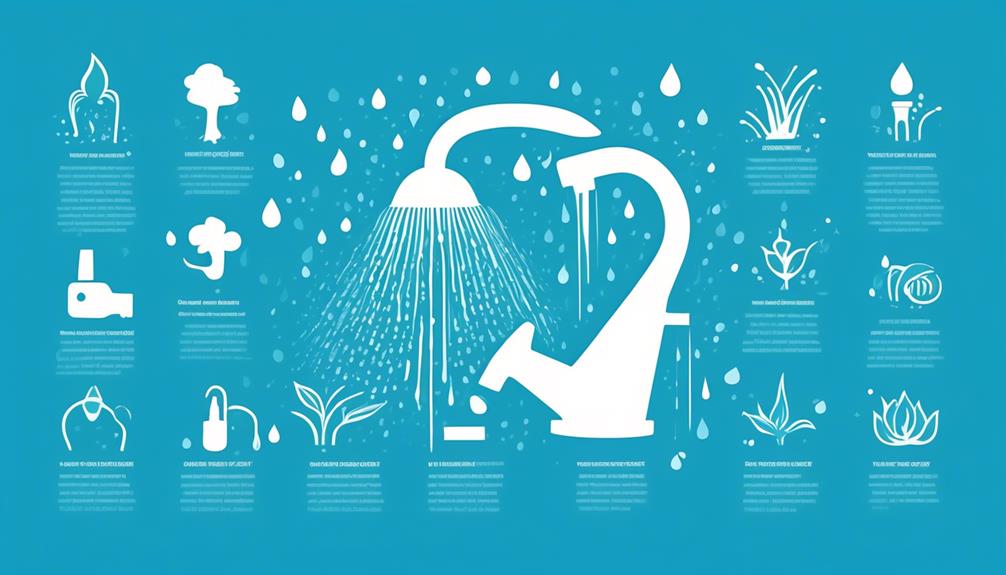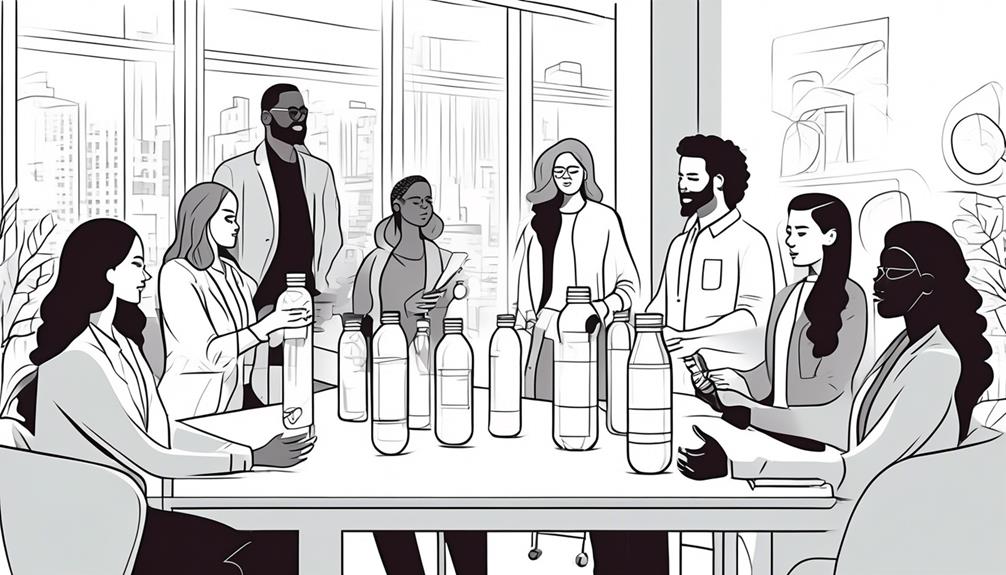Did you know that according to the United Nations, by 2025, two-thirds of the world's population could be under water stress conditions? It's a staggering figure that highlights the urgent need for effective water conservation campaigns.
To make a real impact and drive change, you need to understand the intricacies of water conservation campaigns. So, let's dive into seven essential tips that can help you create impactful campaigns that resonate with your audience and inspire action.
Key Takeaways
- Recognize the finite nature of water and the impact of global population growth on water scarcity
- Engage with local community leaders to identify water conservation challenges and gather insights on water usage habits
- Develop compelling messaging with clear call-to-action and emotional appeal to motivate people to conserve water
- Set clear goals, utilize data tools, evaluate feedback, and promote inclusivity and diversity for campaign success
Understand the Water Crisis
To grasp the severity of the water crisis, envision a world where every drop counts. Imagine turning on the tap, but only a trickle emerges. Picture dry, cracked earth where lush gardens once bloomed. This is the reality faced by many communities worldwide. Water scarcity isn't just a distant problem—it affects us all.
Understanding the water crisis begins with recognizing the finite nature of this precious resource. With a growing global population and increasing demands for water, conservation is no longer a choice but a necessity. Every action we take, from brushing our teeth to watering our plants, can either contribute to the solution or exacerbate the problem.
Target the Right Audience
Consider tailoring your water conservation message to resonate with specific groups who can make a meaningful impact on preserving this vital resource. To effectively target the right audience for your water conservation campaign, follow these tips:
- Understand Community Needs:
- Engage with local community leaders to identify specific water conservation challenges in different neighborhoods.
- Conduct surveys or focus groups to gather insights on the water usage habits and attitudes of residents.
- Collaborate with schools or youth organizations to educate the next generation about the importance of water conservation.
Develop Compelling Messaging
When crafting your water conservation messages, remember three key elements:
- A clear call-to-action to prompt action.
- An emotional appeal to connect with your audience.
- Visual impact to make your message memorable.
By incorporating these components, you can create compelling messaging that motivates people to conserve water and make a positive impact on the environment.
Keep these points in mind as you develop your campaigns to effectively engage and inspire others to join the conservation efforts.
Clear Call-to-Action
Crafting a compelling message is essential for motivating individuals to take action in water conservation campaigns. To develop a clear call-to-action that resonates with your audience, consider the following tips:
- Keep it Simple: Use clear and concise language to make your message easily understood.
- Avoid jargon or technical terms that may confuse the audience.
- Highlight Benefits: Clearly outline the positive impact of taking action to encourage participation.
- Show how individual actions contribute to a larger conservation effort.
- Provide Clear Instructions: Clearly state what actions you want the audience to take and how they can do so.
- Use actionable language like 'Join us today' or 'Take the pledge' to prompt immediate engagement.
Emotional Appeal
To amplify the impact of your water conservation campaign, infuse your messaging with emotional appeal that tugs at the heartstrings of your audience. Create stories that evoke empathy and connection, like showcasing how water scarcity affects families or wildlife.
Use visuals that depict the consequences of water wastage, such as dried-up landscapes or struggling communities. By tapping into emotions like compassion, guilt, or hope, you can inspire action and behavioral change.
Craft messages that make people feel personally invested in saving water, emphasizing the collective responsibility we have towards our planet's resources.
Visual Impact
Infuse your water conservation campaign with visually compelling messaging that grabs attention and drives home the importance of saving this precious resource. To engage your audience effectively, consider the following:
- Use striking imagery: Incorporate vibrant visuals of water bodies in contrasting states to evoke strong emotions.
- Show before-and-after scenes: Display images of drought-stricken land transforming into lush greenery with water conservation efforts.
- Employ clear infographics: Create simple yet powerful graphics illustrating water usage statistics and the impact of conservation.
- Highlight key data points: Use graphs and charts to visually represent water wastage and potential savings.
- Utilize interactive elements: Develop interactive campaigns that allow viewers to participate in virtual water-saving scenarios.
- Provide actionable tips: Offer practical solutions that users can implement in their daily lives to conserve water effectively.
Utilize Visual Storytelling

When it comes to water conservation campaigns, utilizing visual storytelling can make a significant impact. Images have the power to convey a message more strongly than words alone.
Image Impact
Using visual storytelling in water conservation campaigns can significantly enhance audience engagement and understanding.
When incorporating images into your campaign, consider the following to maximize impact:
- Emotional Connection: Use visuals that evoke emotions like empathy or urgency to drive action.
- Show images of dry, cracked land to depict the effects of drought.
- Before and After: Demonstrate the impact of water conservation efforts by showcasing visual transformations.
- Display side-by-side images of a barren landscape and a flourishing garden post-conservation.
- Infographics: Simplify complex data or tips into visually appealing graphics for easy comprehension.
- Create infographics showing water-saving tips with accompanying illustrations.
Storytelling Strength
Visual storytelling in water conservation campaigns enhances engagement and understanding. By weaving a compelling narrative through impactful images, you can emotionally connect with the audience. These visuals convey messages simply and effectively, resonating on a deeper level.
Whether showcasing clean water sources' beauty or highlighting conservation urgency, visual storytelling evokes empathy and drives action. Captivating images inspire change, motivating individuals towards water conservation.
Visual Engagement
Engaging your audience through captivating imagery can significantly amplify the impact of your water conservation message. To make the most of visual storytelling, follow these engaging strategies:
- Utilize Infographics: Simplify complex data into visually appealing graphics to convey information effectively.
- Share Before and After Images: Show the impact of water conservation efforts through visually contrasting images.
- Create Shareable Memes: Use humor and creativity to make your message go viral and reach a wider audience.
Collaborate With Influencers

To enhance the reach and impact of water conservation campaigns, consider partnering with influential individuals who can amplify the message to a wider audience. Collaborating with influencers can significantly boost the visibility and effectiveness of your conservation efforts. Influencers have dedicated followers who trust their opinions and are more likely to engage with content they endorse.
—
| Benefits of Collaborating with Influencers | Example | Impact |
|---|---|---|
| Extended Reach | An influencer shares your campaign with their followers, reaching thousands of new individuals who may not have been exposed to your message otherwise. | Increases awareness and engagement. |
| Credibility | Followers trust the influencer's recommendations, lending credibility to your campaign and motivating more people to participate in water conservation activities. | Builds trust and legitimacy. |
| Diverse Audiences | Influencers come from various backgrounds and niches, allowing you to connect with a broader range of people who can contribute to water conservation efforts in unique ways. | Promotes inclusivity and diversity. |
—
Track and Analyze Campaign Impact
Quantify the impact of your water conservation campaigns by systematically tracking and analyzing their effectiveness. To ensure your efforts are making a difference, consider the following:
- Set Clear Goals: Define specific and measurable objectives for your campaign to have a benchmark for success.
- Example: Aim to reduce water consumption by 15% in targeted areas within six months.
- Utilize Data Tools: Use online analytics platforms or survey tools to gather data on engagement levels, reach, and behavior changes.
- Example: Track website visits, social media interactions, and survey responses to gauge audience response.
- Evaluate Feedback: Encourage participants to provide feedback on the campaign's impact and use this information to make improvements.
- Example: Conduct post-campaign surveys to gather insights on changes in water usage habits.
Frequently Asked Questions
What Are Some Creative Ways to Incorporate Water Conservation Messaging Into Everyday Activities?
Incorporate water conservation messages into daily routines effortlessly. Use catchy slogans on bathroom mirrors, switch to water-saving devices, and share quick tips on social media. Small changes can make a big impact on preserving water resources.
How Can Local Businesses and Organizations Get Involved in Water Conservation Campaigns?
To get involved in water conservation campaigns, local businesses and organizations can partner with environmental groups, host educational workshops, implement water-saving practices, sponsor community events, promote awareness on social media, and collaborate on conservation initiatives.
What Role Can Social Media Platforms Play in Spreading Awareness About Water Conservation Efforts?
Social media platforms can amplify water conservation efforts by reaching a wide audience quickly. You can share tips, infographics, and success stories to inspire action. Engage followers through challenges, live streams, and interactive content for maximum impact.
Are There Any Specific Tips for Engaging Younger Generations in Water Conservation Initiatives?
To engage younger generations in water conservation initiatives, make it interactive and fun. Use social media challenges, gamify learning about water conservation, and organize community events. Show them how their actions can make a real difference.
How Can Individuals Measure Their Own Water Usage and Track Their Impact on Conservation Efforts?
To measure your water usage and track conservation efforts, start by noting drips as drops in a bucket. Use a water meter or online tools for precise tracking. Small changes add up to big impacts!
Conclusion
Now that you have these essential tips for water conservation campaigns, put them into action and make a difference!
For example, a city in California successfully reduced water usage by 20% through a targeted campaign aimed at educating residents on simple ways to conserve water.
By understanding the water crisis, targeting the right audience, and utilizing compelling messaging, you can create impactful campaigns that inspire change.
Start conserving water today!
